Antinol® Latest Studies
Sorted by recent
 Filter Studies by Smart Tags
Filter Studies by Smart Tags
Bone & JointCardiovascularCase Study & ProceedingCatDogEAB 277™EfficacyExotic PetImmunologyNeuro & BehaviorOphthalmologyOralRabbitRenalRespiratoryRodentSafetySkinUTI
Smart Search
Evaluation of the comparative efficacy of green lipped mussel plus krill oil extracts (EAB-277), Biota orientalis extracts or NSAIDs for the treatment of dogs with osteoarthritis associated pain: a blinded, placebo-controlled study

With little to no regulation of the supplement markets and a paucity of quality information regarding clinical utility of individual marketed supplements, it is difficult for veterinarians to provide any evidence-based recommendations to owners. The current study aimed to provide clinically useful comparative efficacy data on certain marketed supplements.
Discussion: Results of this study indicate that meloxicam and EAB-277 have significant objectively measured benefits in managing OA-related pain in dogs compared to placebo, but 4CYTE does not differ from placebo.
Antinol® EAB-277® – The Executive Summary

Antinol® Rapid is a potent synergistic blend of 2 marine lipid extracts chosen for their unique enhancement formula called EAB-277®.
EAB-277® is the key active ingredient of this advanced formula formulated to promote optimal benefits through its synergistic efficacy contains > 90 free fatty acids full spectrum of Omega 3 including ETA, EPA, DHA as well as other key Polyunsaturated fatty acids (PUFAs) and antioxidants.
The two marine lipids used in Antinol® Rapid are proprietary and exclusively produced. The exact combination of 30mg lipid fractions from Perna canaliculus (New Zealand green lipped mussel) and 20mg high phospholipid krill oil is the result of years of research combining and isolating lipid groups and essential fatty acids to find the optimal nutrient synergy.
EAB-277®’s proprietary high phospholipid krill oil is high in polar lipid enrichment which enhances bioactivity “Potency” of this marine oil blend formula as a result of proven efficacy.
The Antinol® Rapid EAB-277® blend has been proven via laboratory tests to be more effective than either of the individual lipids alone in inhibiting inflammation markers such as nitric oxide, TNFα, and IL-6.



Study of the effectiveness of glucosamine and chondroitin sulfate, marine based fatty acid compounds (PCSO-524 and EAB-277), and carprofen for the treatment of dogs with hip osteoarthritis: A prospective, block-randomized, double-blinded, placebo-controlled clinical trial


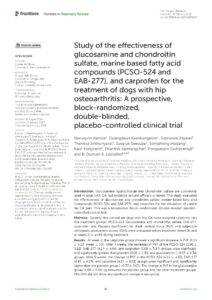
Canine tracheal collapse is a progressive disease in small breed dogs resulting from chronic inflammation of the tracheal mucosal lining. Polyunsaturated fatty acid EAB-277® is one of the nutraceuticals that can alleviate inflammation and oxidative stress. Heart rate variability (HRV) is a prognostic tool related to sympathovagal balance and oxidative stress level, which is widely used with cardiorespiratory diseases. However, the effect of EAB-277® on HRV in tracheal collapse dogs has rarely been investigated.
Introduction: Glucosamine hydrochloride and chondroitin sulfate are commonly used in dogs with OA, but evidence around efficacy is mixed. This study evaluated the effectiveness of glucosamine and chondroitin sulfate, marine based fatty acid compounds (PCSO-524 and EAB-277), and carprofen for the alleviation of canine hip OA pain. This was a prospective, block-randomized, double-blinded, placebo-controlled clinical trial.
Methods: Seventy-five owned pet dogs with hip OA were assigned randomly into five treatment groups: PCSO-524, Glucosamine and chondroitin sulfate, EAB-277, carprofen, and Placebo (sunflower oil). Peak vertical force (PVF) and subjective orthopedic assessment scores (OAS) were evaluated before treatment (week 0), and at weeks 2, 4, and 6 during treatment.
Results: At week 2, the carprofen group showed a significant increase in PVF (3.14 ± 5.33; mean ± SD). After 4 weeks, the increases in PVF of the PCSO-524 (3.90 ± 3.52), EAB-277 (4.17 ± 4.94), and carprofen (3.08 ± 5.87) groups were significant, and significantly greater than placebo (0.08 ± 1.90) and glucosamine (−0.05 ± 6.34) groups. After 6 weeks, the change of PVF in the PCSO-524 (4.14 ± 4.65), EAB-277 (4.45 ± 4.23), and carprofen (4.21 ± 6.52) groups were significant and significantly higher than the placebo group (−0.33 ± 3.65). The change in PVF in the glucosamine group (1.08 ± 5.49) lay between the placebo group and the other treatment groups. The OAS did not show any significant change in any group.
Discussion: PCSO-524 and EAB-277, but not glucosamine/chondroitin, resulted in significant improvements in PVF from baseline after 4 weeks, and 6 weeks, and to a similar degree to that seen with carprofen.

The Effectiveness of Marine Based Fatty Acid Compound (PCSO-524) and Firocoxib in the Treatment of Canine Osteoarthritis

This randomized double blinded study included 79 mixed breed dogs that had hip and/or stifle OA with X-ray confirmation. Outcome measures were changes in Kinetic force plate gait analysis-Peak Vertical Force (PVF), the Orthopedic Assessment Score (OAS), Canine Brief Pain Inventory score (CBPI), and serum prostaglandin E2 concentration (PGE2).
The results of the study suggest that within each group of a combination (PCSO-524 and Firocoxib), PCSO-524, Firocoxib showed the significant improvement of weight bearing ability but not in the comparison between.
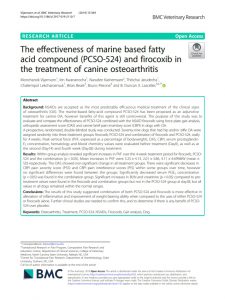

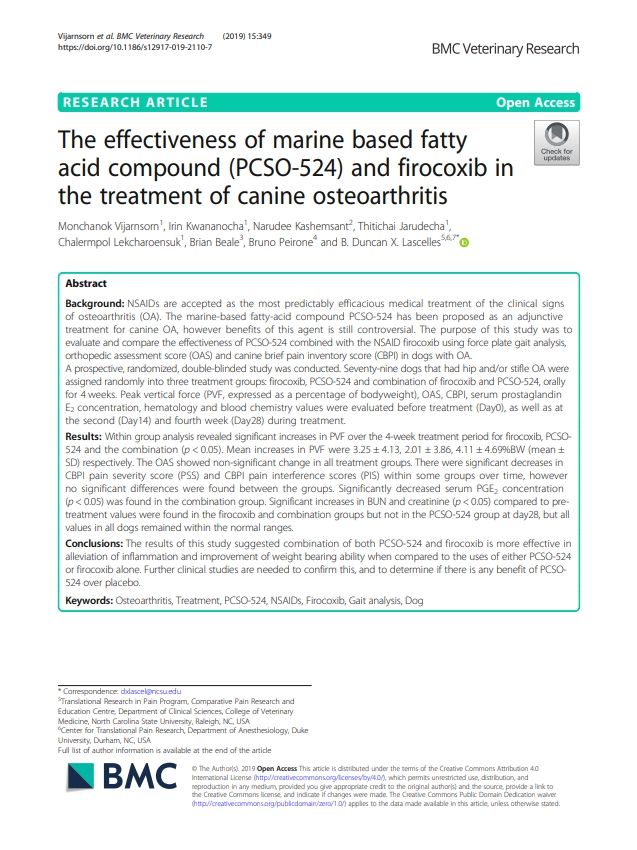
The Effectiveness of Marine Based Fatty Acid Compound (PCSO-524) Alone and Combined with Firocoxib in the Treatment of Canine Osteoarthritis

(VOS conference, March 2018)
This randomized study involved 31 mixed breed dogs with x ray confirmed OA of stifle joint. They were split into 2 groups for four weeks of treatment.
The results showed a non-significant effect of the treatment on the adjusted Peak Vertical Force (PVF) value (p=0.447) among the 2 treatment groups.
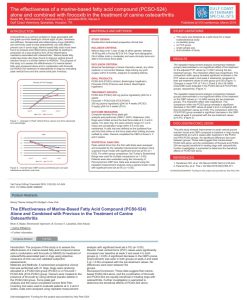
![]()
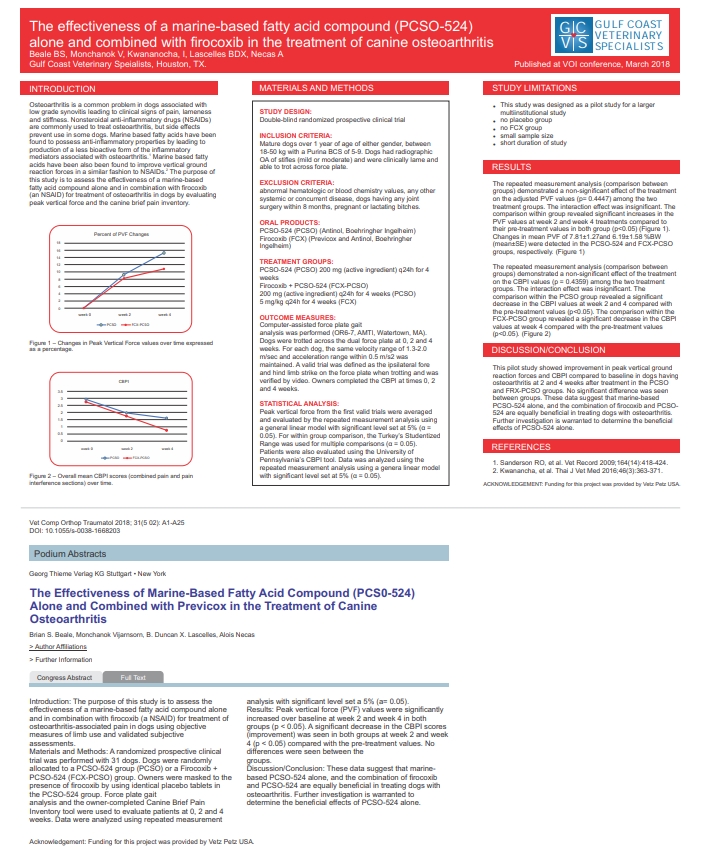

The Effectiveness of Marine Based Fatty Acid Compound (PCSO-524) and Firocoxib in the Treatment of Canine Osteoarthritis.

This randomized double blinded study included 79 mixed breed dogs that had hip and/or stifle OA with X-ray confirmation. Outcome measures were changes in Kinetic force plate gait analysis-Peak Vertical Force (PVF), the Orthopedic Assessment Score (OAS), Canine Brief Pain Inventory score (CBPI), and serum prostaglandin E2 concentration (PGE2).
The results of the study suggest that within each group of a combination (PCSO-524 and Firocoxib), PCSO-524, Firocoxib showed the significant improvement of weight bearing ability but not in the comparison between.
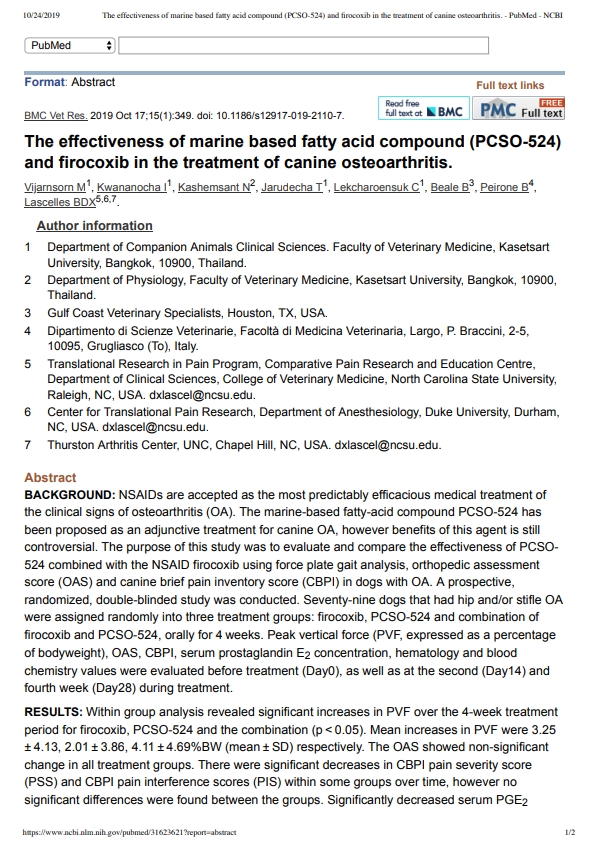
Use of PSCO-524® (Antinol®) and Casting for Treatment of Tetraparesis and Neck Pain Due to Atlantoaxial Instability and Subluxation of the 1st-2nd Cervical Vertebrae

A 7 months old male Pomeranian dog was admitted to Thong Lor animal hospital for signs of intermittent leg paresis and hyperesthesia during the past 2 weeks.
Physical examination found grade II tetraparesis, neck hyperflexion, spasm of cervical muscle, and cervical hyperesthesia.
X-ray examination showed atlantoaxial instability and dorsal subluxation of the first and second cervical vertebrae. The disease is congenital and commonly found in toy breed dogs (Itoh H. et al, ).
A cast was used to stabilize the joints for 12 weeks in conjunction with medicinal treatment including pain killer medicine, gabapentin, and 1 capsule of PSCO-524® (Antinol®) sid.
After one week of the treatment, the dog showed no sign of pain when touched but the signs of hind limb paresis still remained. The treatment was continued until the 10th week that gabapentin was terminated and no recurrence of pain was detected since then.
After 12 weeks of the treatment, the cast was removed and PSCO-524® (Antinol®) 1 capsule sid was continued and the dog did not show any progressive development of clinical signs.
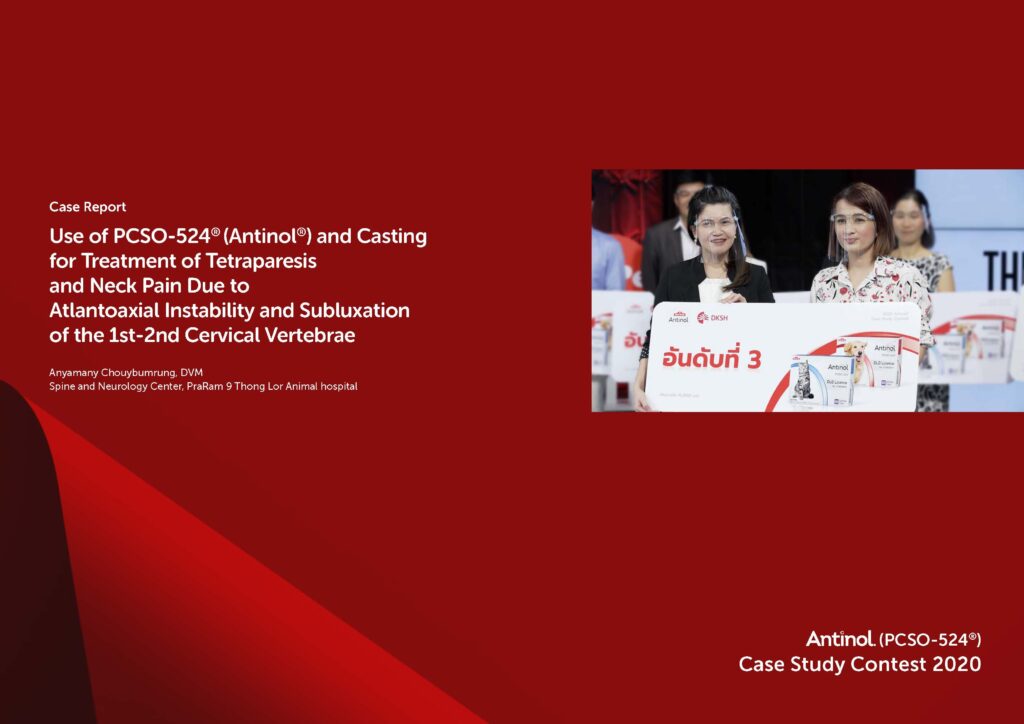
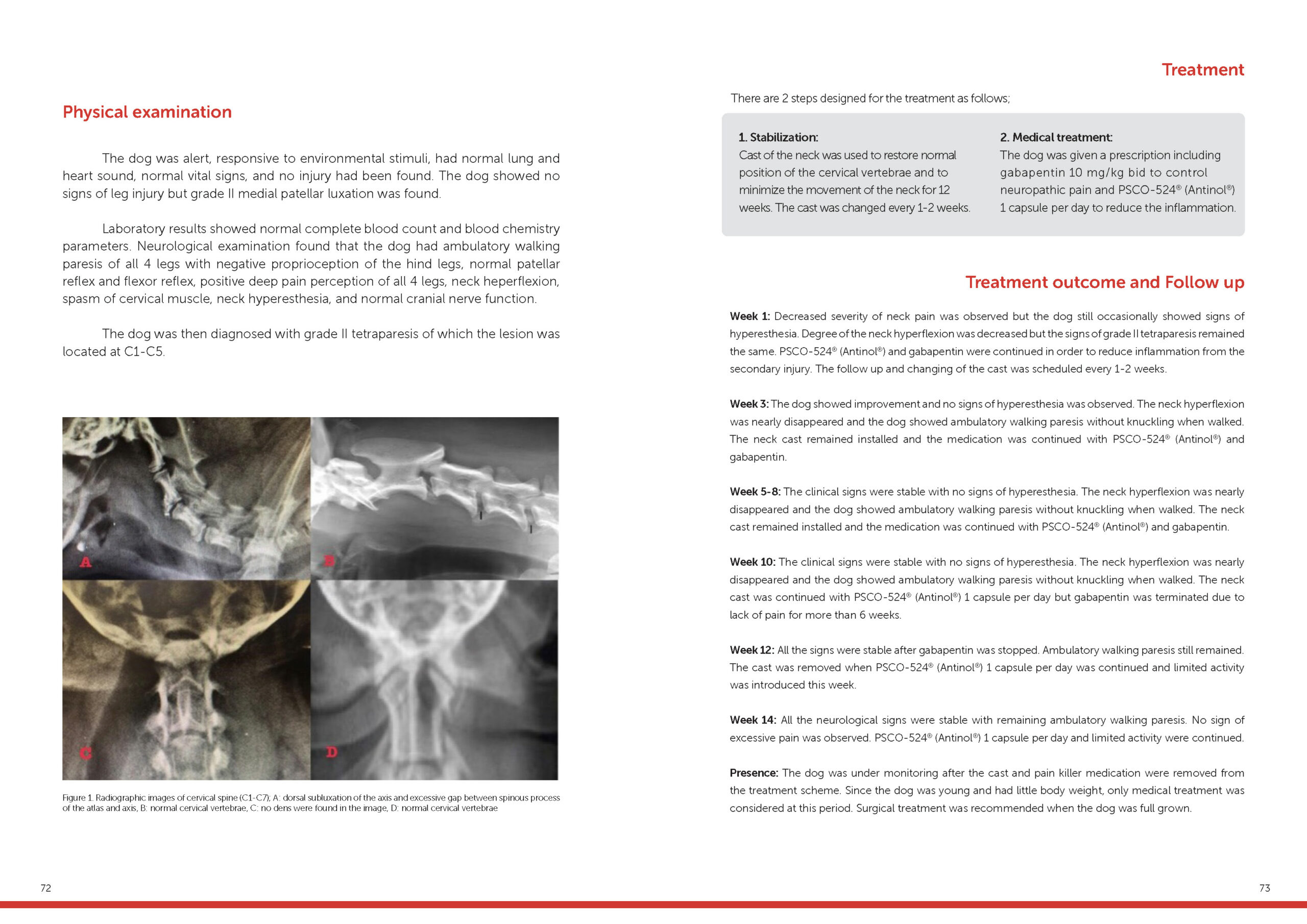
Use of PCSO-524® with Physical Rehabilitation to Regain Mobility in Dogs after Femoral Head and Neck Excision

An 8 years old Pomeranian dog showed acute non weight-bearing lameness of the right hind limb after high jumping. Preliminary examination identified pain at the right hip and radiographic images revealed right hip luxation.
Femoral head and neck excision was performed for the surgical treatment.
Multimodal treatment scheme deployed after the surgery consisted of neutraceutical PCSO-524® and physical rehabilitation using laser class 4, exercise such as Cavaletti exercise, balanced board, walking on treadmill, and hydrotherapy including walking under water and swimming.
Evaluation of the treatment during follow-up showed decreased pain score and severity of lameness, which was consistent with the owner’s report that described improvement of weight- bearing of the right hind limb and the quality of life.
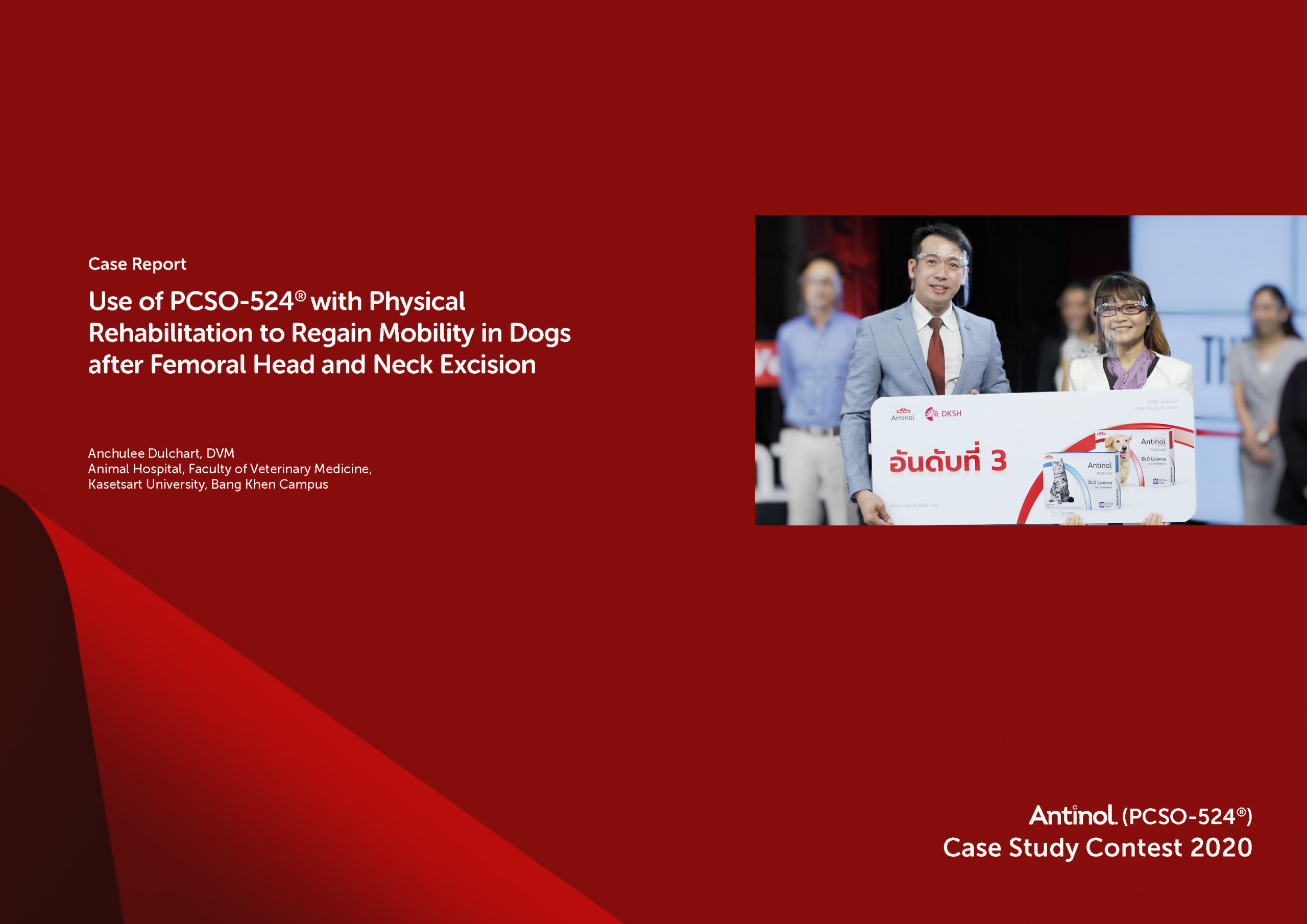
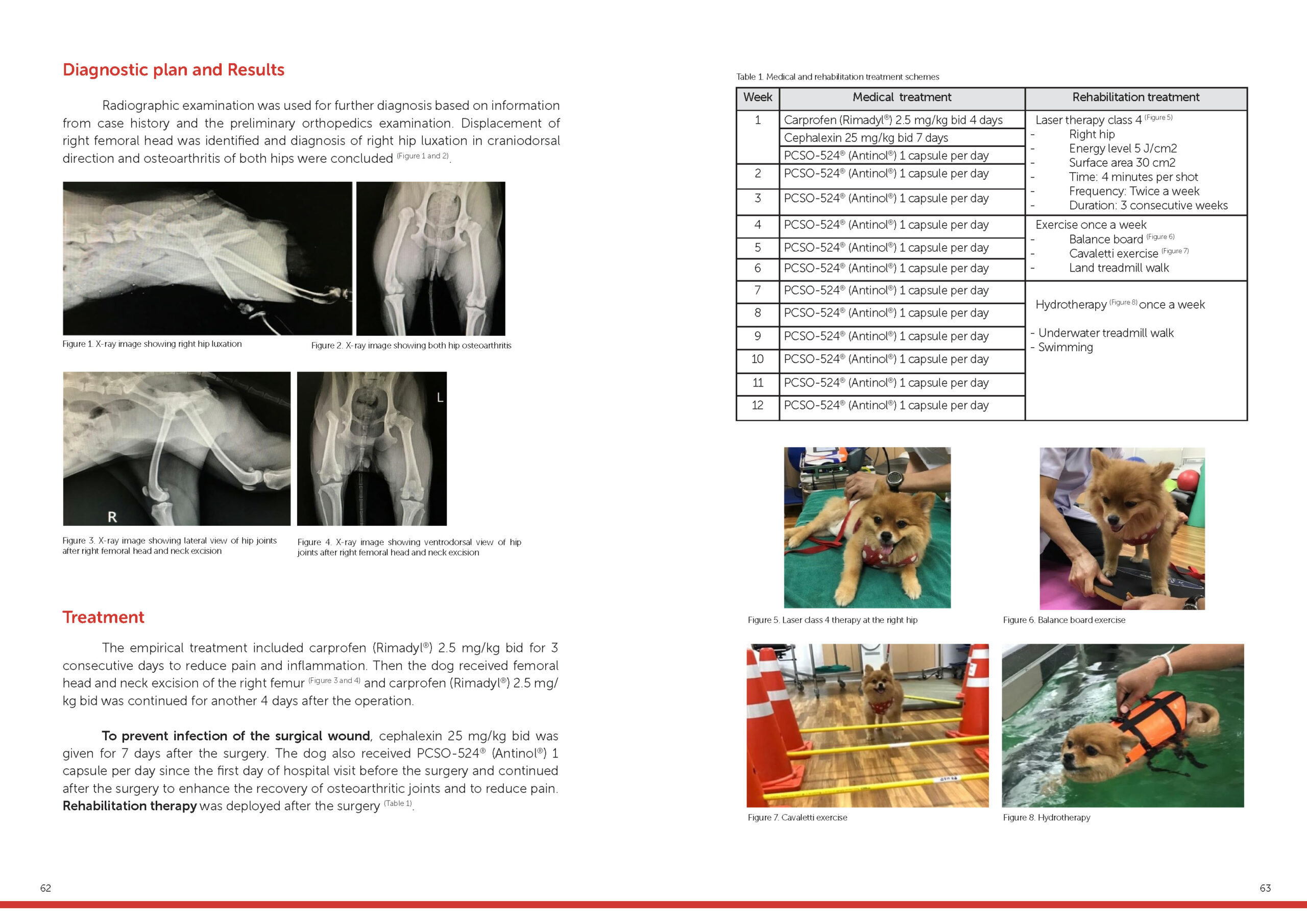
Use of PCSO-524® and Cyclosporin for Treatment of Immune-Mediated Polyarthritis in Dogs

An 8 years old Chihuahua dog was admitted to the Small Animal Hospital at Chulalongkorn University due to signs of depression, lethargy, lameness and joint effusion. Hematological examination and test of synovial fluid indicated Immune-Mediated Polyarthritis (IMPA).
Prednisolone, Gabapentin and Amoxillin-clavulanic acid were prescribed for the treatment. Abnormally increase of ALT, ALK and AST enzyme was observed 1 week later, therefore, the treatment was changed to Cyclosporin, Gabapetin, and PCSO-524®. The clinical signs continued to improve after the adjustment of prescription and Cyclosporin and Gabapetin were terminated after 3 and 4 months, respectively.
A follow-up examination at 4 months later showed no signs of lameness and joint effusion and no adverse effects caused by the long-term use of PCSO-524®.
The success of IMPA treatment is a result of rapid diagnosis and appropriate treatment protocol. Follow-up for treatment evaluation is necessary during the treatment course in order to reduce the impact on health and minimize the medication dosage without risk of causing adverse effects or recurrence of the disease.

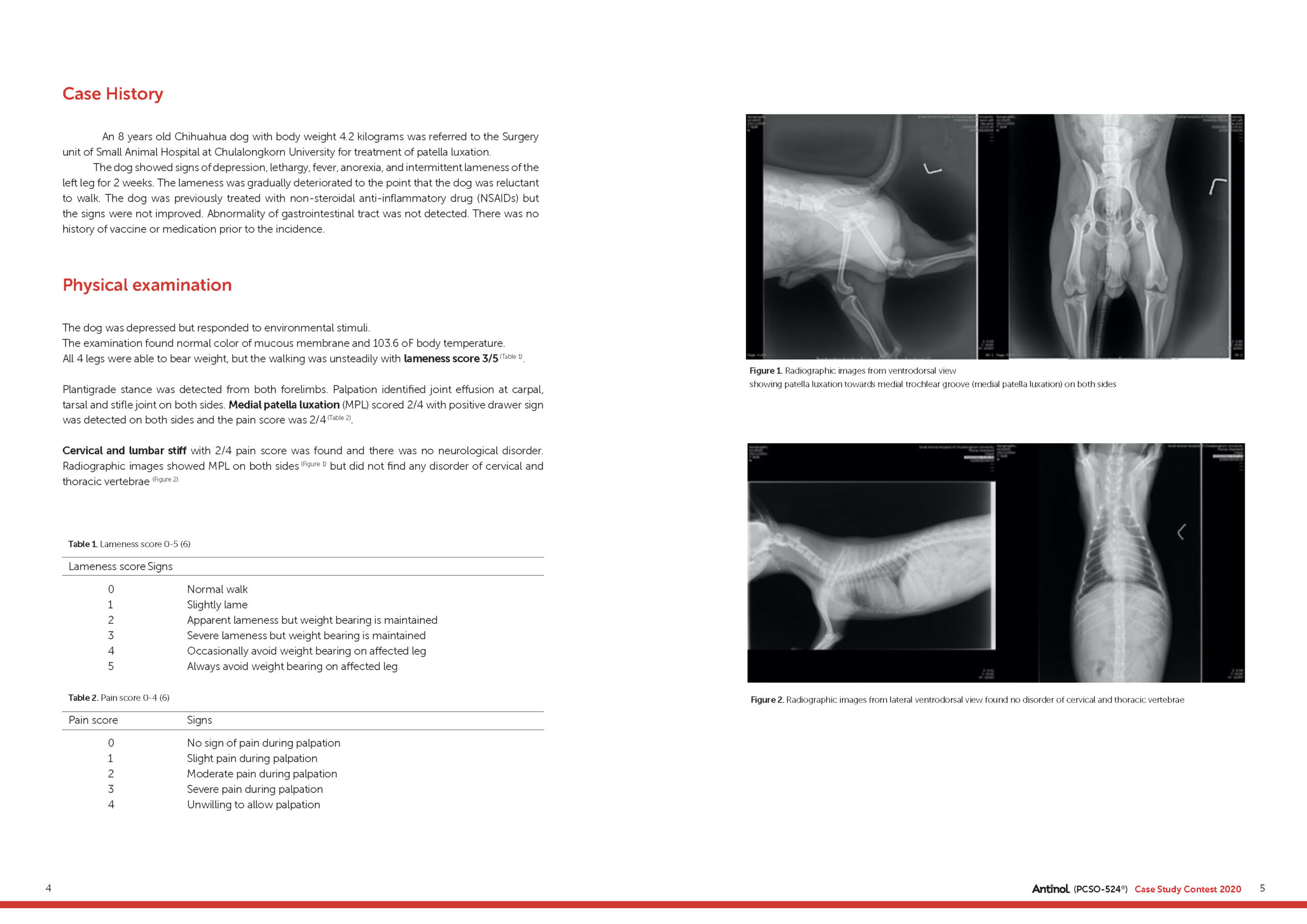
PCSO-524® for Treatment of Immune-Mediated Polyarthritis in Dogs

An 8-year old Chihuahua dog was admitted for surgical treatment of patella luxation at Small Animal Hospital of Chulalongkorn University, Thailand.
At 2 weeks prior to the hospital visit, the dog showed signs of fever, anorexia, lethargy, and lameness of the left leg. Non-steroidal anti-inflammatory drug (NSAIDs) was prescribed at that time but the dog had no response to the treatment.
The dog received prednisolone 0.6 mg/kg bid, gabapentin 10 mg/kg sid, samylin® liver supplement 1 tablet sid, and amoxicillin-clavulanic acid 20 mg/kg sid in the first week of the treatment. Then prednisolone was stopped due to elevation of liver enzymes; AST, ALT, and ALK.
The following 1-month treatment course included cyclosporine 6 mg/kg bid, gabapentin 10 mg/kg bid, samylin® 1 tablet sid, and PCSO-524® 1 capsule bid.

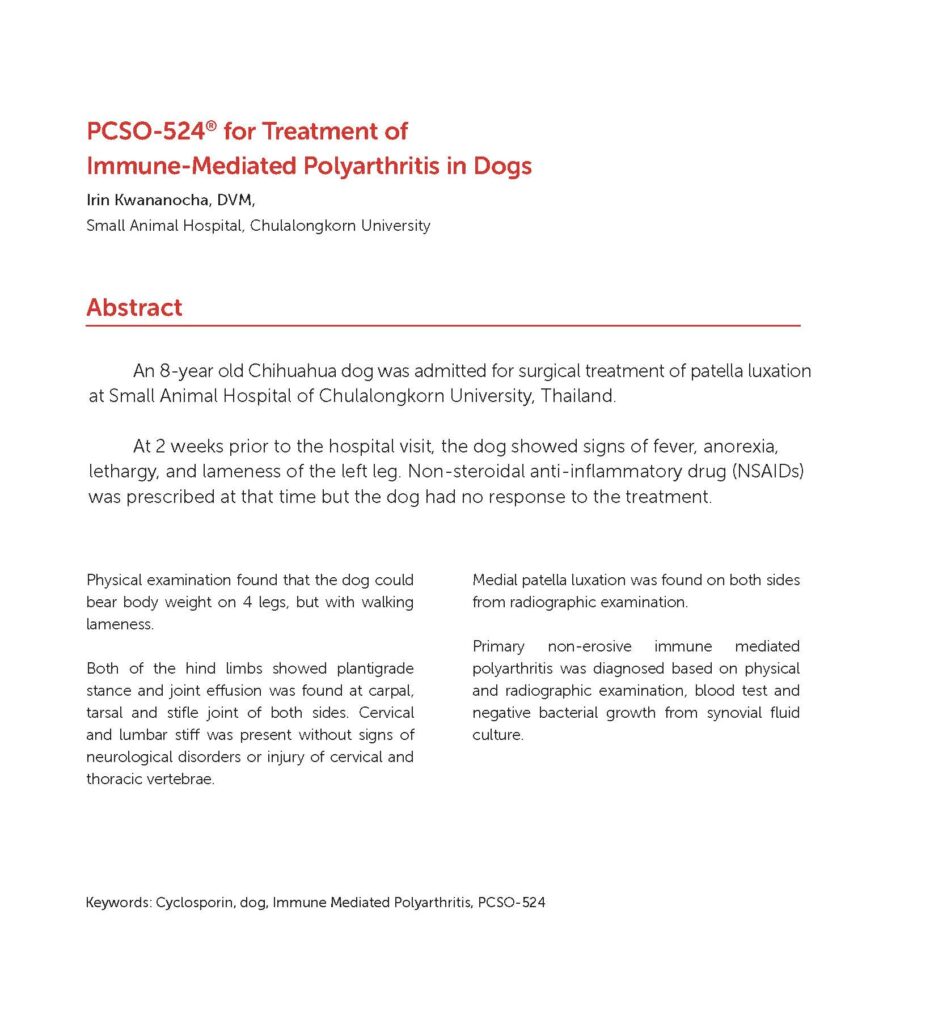

This article was summarized from the original article published in The Journal of Thai Veterinary Practitioners by the permission of Veterinary Practitioner Association of Thailand (VPAT)
Updated Study Topics
New researches and publications related to PCSO-524® and its result in clnical test submitted by veterinarians on the global conferences every year and the data keeps growing with more studies conducted


 Authors:
Authors: